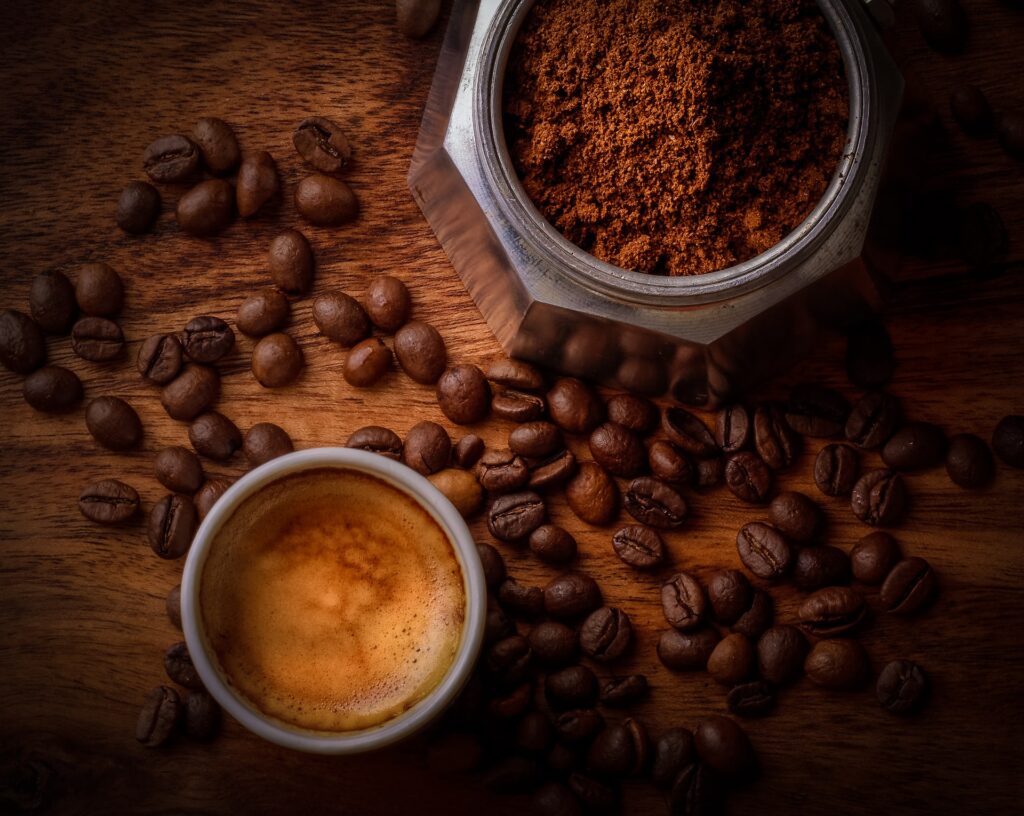We all know that coffee is made from beans, but have you ever wondered how those beans become the premium beans we know and love?
It turns out that there is a lot more to it than just planting and picking coffee beans. In fact, there is a whole process that goes into making sure those beans are of the highest quality.
In this blog post, we will explore how coffee beans become premium beans. From the planting and harvesting process to the roasting and brewing, we will cover everything you need to know about how your coffee is made. So sit back, relax, and enjoy a cup of American Joe as you learn about the intricate process that goes into making it.
The coffee plant and the coffee bean

The coffee plant is a shrub that produces small, red fruit, known as coffee cherries. Each cherry contains two seeds, or beans, which are used to make coffee.
Coffee plants are grown in countries around the world with tropical climates, including Brazil, Colombia, Guatemala, and Ethiopia. The plants thrive in humid conditions and rich soil.
Once the coffee cherries are ripe, they are picked by hand and then placed in sacks for transport. The cherries are sorted by ripeness and quality before they are sent to a processing facility.
At the processing facility, the coffee cherries are hulled to remove the outer fleshy part of the fruit. The beans are then washed and sorted before they are dried.
Once the beans are dried, they are roasted to create the signature flavor of coffee. Roasting also removes any remaining moisture from the bean. After roasting, the beans are ground and brewed to create a cup of coffee.
The coffee bean is the seed of the coffee plant. The bean is encased in a thin outer shell, known as the parchment. The bean is surrounded by the endosperm, which is a starchy tissue that contains nutrients for the embryo.
The coffee bean is rich in caffeine, a stimulant that has a range of effects on the human body. Caffeine increases alertness and can improve focus and concentration. It also has a diuretic effect, which means it can help to prevent dehydration.
Caffeine is a psychoactive drug, which means it can alter a person’s mood and state of consciousness. Caffeine is addictive and can lead to withdrawal symptoms, such as headaches and fatigue, if a person suddenly stops consuming it.
Coffee beans are typically green before they are roasted. The roasting process causes the beans to turn brown and expand in size. Roasting also develops the flavor of the bean.
There are four main types of coffee beans, which are distinguished by their color and flavor profile.
Arabica beans are the most popular type of coffee bean. They make up about 60% of the world’s coffee production. Arabica beans are light-bodied and have a mild flavor with hints of fruit and chocolate.
Robusta beans are less popular than Arabica beans but make up a significant portion of the world’s coffee production. Robusta beans are more bitter than Arabica beans and have a higher caffeine content.
Liberica beans are a rare type of coffee bean that is grown in West Africa and Southeast Asia. Liberica beans have a strong flavor with notes of floral aromas and fruits.
Excelsa beans are another rare type of coffee bean that is grown in Vietnam, Cambodia, Laos, and Thailand. Excelsa beans have a fruity flavor with hints of spices such as cinnamon and clove.
Coffee beans are graded based on their size, shape, and color. The highest quality beans are uniform in size and shape and have a deep green color. Lower quality beans are smaller, more misshapen, and lighter in color.
Coffee beans are also graded based on their country of origin. The designation “Arabica” or “Robusta” denotes the country of origin for the bean.
The term “single origin” coffee refers to coffee that is made from beans that all come from the same country. The term “blend” refers to coffee that is made from a mixture of beans from different countries.
Coffee beans are roasted to develop their flavor and aroma. The roast level is determined by how long the bean is roasted and at what temperature.
The lightest roast is known as a “light roast”, which has a light brown color and a mild flavor. A “medium roast” has a medium brown color and a more pronounced flavor. A “dark roast” has a dark brown color and a strong flavor.
The roasting process also affects the caffeine content of the bean. Light roasted beans have a higher caffeine content than dark roasted beans.
Coffee beans are typically ground before they are brewed. The grind size is determined by the brewing method. A finer grind is typically used for espresso while a coarser grind is used for drip coffee.
The grind size can also be adjusted to control the strength of the coffee. A finer grind will produce a stronger cup of coffee while a coarser grind will produce a weaker cup of coffee.
Brewing coffee is the process of extracting the flavor and aromas from the ground beans using water. There are many different methods for brewing coffee, including drip, French press, and espresso.
Drip brewing is the most common method for brewing coffee. Hot water is dripped over the ground beans and then filtered through a paper filter. The resulting coffee is typically lighter in body and has less bitterness than other brewing methods.
French press brewing involves steeping the ground beans in hot water for several minutes before pressing the plunger down to filter the grounds from the liquid. French press coffee has a fuller body and more bitterness than drip coffee.
Espresso brewing involves forcing hot water through tightly packed ground beans using high pressure. Espresso is typically served in small doses and has a strong flavor.
Cappuccino is a type of coffee that is made by combining espresso with steamed milk and foam. The milk and foam add sweetness and creaminess to the coffee.
Latte is another type of coffee that is made by combining espresso with steamed milk. Latte has less foam than cappuccino and is typically sweeter.
Mocha is a type of coffee that is made by combining espresso with chocolate and steamed milk. Mocha has a sweet and rich flavor.
Americano is a type of coffee that is made by adding hot water to espresso. Americano has a weaker flavor than espresso but is less bitter.
Coffee beans can be roasted at home using a coffee roaster. Home roasting allows the coffee drinker to control the roast level and create their own unique blends.
Coffee beans can also be bought pre-roasted from specialty stores. Pre-roasted beans are typically more expensive but offer a wider range of flavors.
How does coffee becomes a premium coffee beans?
Coffee beans go through a lot to become premium coffee beans. The coffee plant is native to Ethiopia and was first cultivated in the Arabian Peninsula. Coffee plants are now grown in more than 70 countries, with Brazil being the largest producer of coffee beans.
After the coffee beans are harvested, they are processed and then roasted. The roasting process is what gives coffee its unique flavor. Different roast levels produce different flavors, so it’s important to find the right roast for your taste.
Once the coffee beans are roasted, they are ground and brewed to create your favorite cup of coffee. Premium coffees use only the highest quality beans that have been expertly roasted and ground. This ensures a rich, flavorful cup of coffee every time.
The coffee roasting process
The coffee roasting process is a critical step in achieving the perfect cup of coffee. The beans are first sorted and then roasted at a high temperature to bring out their natural flavor.
After the beans are roasted, they are cooled and then ground to the desired size. The type of grind you use will depend on your brewing method. For example, a French press requires a coarser grind than an espresso machine.
Once the beans are ground, they are ready to be brewed. The brew time and temperature will also affect the final flavor of your coffee. For example, darker roast coffees generally require a shorter brew time than lighter roasts.
Brewing coffee is an art and science all its own. But with a little practice, you can easily make delicious coffee at home using your favorite beans.
The different types of coffee beans
There are two main types of coffee beans: Arabica and Robusta. Arabica beans are grown in higher altitudes and have a sweeter, more delicate flavor. Robusta beans are hardier and have a stronger, more bitter flavor.
The different types of coffee beans each have their own unique flavor profile that is influenced by the environment in which they are grown. For example, Arabica beans grown in Brazil tend to have a nutty flavor, while those grown in Ethiopia tend to be more fruity.
It is important to choose the right type of bean for your desired flavor profile. If you want a light and delicate coffee, choose an Arabica bean. If you prefer a bolder and stronger coffee, go for a Robusta bean.
Conclusion
The coffee bean journey from farm to cup is a long and complicated one. But in a nutshell, the coffee beans go through a process of being picked, dried, roasted, and then finally ground up and brewed. Along the way, the beans are graded and sorted to ensure that only the best quality beans make it into the final product. It’s a lot of work, but it’s worth it when you take that first sip of delicious premium coffee.



